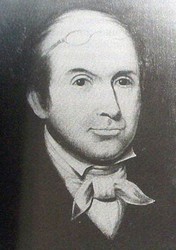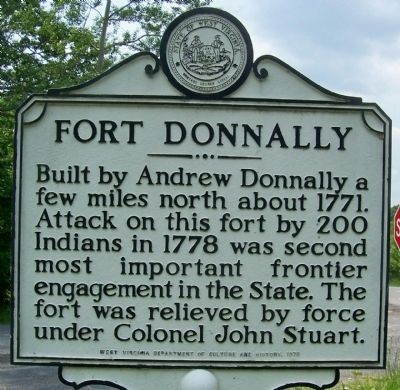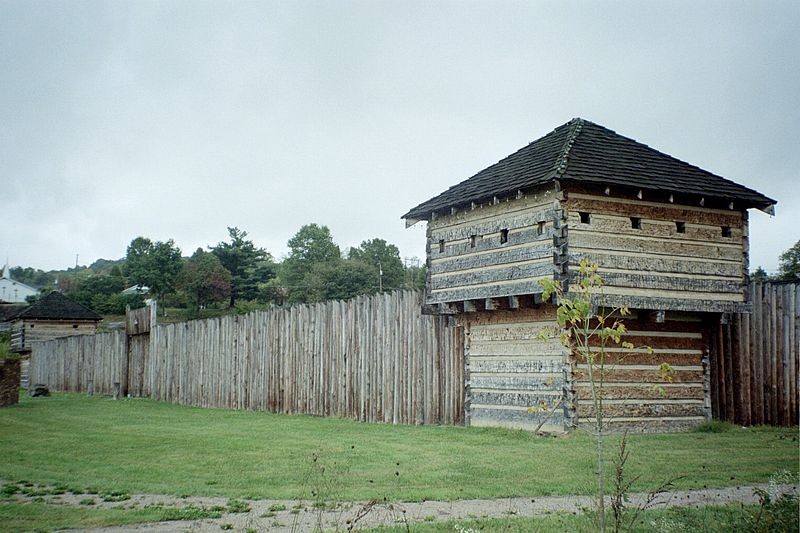1778 Campaign against Forts Randolph and Donnally
Introduction
Text-to-speech Audio
Images
Colonel Andrew Donnally

The Historical Marker for Fort Donnally

Reconstruction of Fort Randolph in Point Pleasant, West Virginia

Backstory and Context
Text-to-speech Audio
Historians believe that the attacks led by Dunquat in 1778 against Forts Randolph and Donnally were at least partially a response to the November 10, 1777 murder of the Shawnee leader Cornstalk by members of the rebel militia at Fort Randolph. Cornstalk, known primarily for his role as the leader of Shawnee forces at the 1774 Battle of Point Pleasant during Dunmore’s War, traveled to Fort Randolph at the confluence of the Ohio and Kanawha Rivers in what became Point Pleasant, West Virginia in the fall of 1777. His aim was to assure the commander at the fort, Captain Matthew Arbuckle, of his continued neutrality in the American War for Independence. Over the course of that conflict, Cornstalk had found it increasingly difficult to convince the young men of his community to remain unaffiliated with either the British or rebels. Most, persuaded by the Shawnee leader Blue Jacket (Weyapiersenwah), chose to side with the British, believing that ally more likely to uphold restrictions on colonial expansion west of the Appalachian Mountains. Corntalk’s murder in the fall of 1777 by rebel colonists ultimately convinced many of those that remained in favor of neutrality to abandon that stance. In the aftermath of that event, the Shawnees sent emissaries to Native groups across the Ohio Country and beyond in search of allies for their intended retaliation against the rebels in that area.
Among those that responded to the Shawnees’ call was Dunquat, a Wyandot leader in the region who at variously times claimed status as an Iroquoian (hence his title of “half king,” a label applied by colonists to Iroquois leaders outside of Iroquois territory). In the spring of 1778, Dunquat gathered together a group of some 200 Wyandot and Mingo fighters to attack Fort Randolph. Dunquat had previously attempted an unsuccessful siege of Fort Henry (now Wheeling, West Virginia) the year before, an attack that resulted in little more than the Natives’ gaining the livestock held outside the fort. His attack against Fort Randolph fared little better. Matthew Arbuckle, absent at the time of the siege, reported that the Indians had quickly surrounded the fort on all sides on May 16 and begun their assault to little avail. The rebels inside, led in Arbuckle’s absence by Captain William McKee, had received advance notice of the attack and stored sufficient water to survive the assault, which lasted a week. Eventually, the personal intervention of Cornstalk’s sister Nonhelema (supporting neutrality still despite her brother’s murder) and the fruitlessness of the effort convinced Dunquat and his supporters to move on. They chose as their next target Fort Donnally, a blockhouse in what is now Greenbrier County, West Virginia.
Realizing the Indians’ next target, McKee called for volunteers to travel overland to warn the rebels at Fort Donnally. Two of the number, Philip Hammond and John Pryor chose to take up the task and Nonhelema assisted in disguising them as Native fighters with war paint. Hammond and Pryor followed quickly in Dunquat’s wake and eventually overtook them, passing through the Indians’ lines to Fort Donnally where they delivered their warning to Colonel Andrew Donnally. Donnally quickly sent similar warnings to his neighbors in the area, who gathered at his blockhouse for protection. Eventually, twenty men had arrived along with sixty women and children, who worked to collect water and other supplies and deposit them in the blockhouse before the Indians could commence their first attack. That attack came on May 29, when fighters under Dunquat attacked the door of the blockhouse with tomahawks and war clubs and nearly battered it down. Among the sentries who repulsed this attack was Dick Pointer, a slave who proved pivotal to the defense through his use of scatter shot that beat multiple attacks on the entrance back over the course of the first day. Pointer’s efforts allowed Colonels Samuel Lewis and John Stuart time to bring in reinforcements, forcing their way past the Indians with a body of sixty men. Ultimately, these reinforcements convinced Dunquat and his men to abandon the siege and the campaign.
With these victories under their belt, the Virginians turned their attention elsewhere. For several months, they made preparations for an assault on the British outposts in the Illinois country, plans that were rendered pointless by the success of George Rogers Clark’s campaign in that region. Eventually, they became part of larger plans to attack the British at Detroit from Fort Pitt. Without the success of rebel arms at Forts Randolph and Donnally, Virginia would have continued to focus considerable resources and attention on the area around those forts rather than on other, more strategically significant goals. In light of that success, meanwhile, white settlers continued to arrive to those areas under the belief that their efforts to establish communities and claim the land for Virginia would be undertaken in relative safety and security.
Cite This Entry
Admin, Clio, Charles Perkins, and Nathan Wuertenberg. "1778 Campaign against Forts Randolph and Donnally." Clio: Your Guide to History. December 31, 2019. Accessed April 28, 2025. https://theclio.com/tour/1596/25
Sources
Colonel Andrew Donnally. Find a Grave. December 23, 2011. Accessed May 02, 2018. https://www.findagrave.com/memorial/82296945/andrew-donnally.
HMBD. Fort Donnally/Border Heroes. April 17, 2018. Accessed May 02, 2018. https://www.hmdb.org/marker.asp?marker=55818.
Kellogg, Louise Phelps. Frontier Advance on the Upper Ohio. Wisconson History Society, 1916.
Renick, Sharelle. Attack on Fort Donnally. West Virginia Division of Culture and History. March 03, 1969. Accessed May 02, 2018. http://www.wvculture.org/history/settlement/fortdonnally04.html.
Virginia Gazette. Defense of Fort Donnally. April 24, 1779. Accessed May 02, 2018. http://www.wvculture.org/history/settlement/fortdonnally03.html.
Wikipedia

